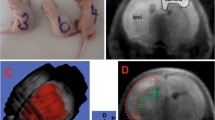Abstract
Free radical-mediated lipid peroxidation has been strongly suggested to be the main cause of neuronal toxicity in the rat brain, including neonatal brain damage. The primary objective of this experiment was to see if the generation of free radicals occurred in the acute phase of ischemic-hypoxic insult in neonatal rats, by electron paramagnetic resonance (EPR) spectroscopy and in vivo brain microdialysis. A spin trap agent, α-(4-pyridyl-N-oxide)-N-tert-butylnitrone was perfused through a probe in the hippocampus before and after hypoxia and then an analysis was performed by EPR. From the EPR analysis of spin adduct in the dialysates, we obtained the EPR spectrum of six line spectra for which the hyperfine coupling constants corresponded to those of the EPR signal from the lipoxygenase/linoleic acid (LPX/LA), a lipid radical generating system, increased transiently just after hypoxia. The results of our in vivo study show the lipid peroxidation of the neuronal membrane to progress during neonatal ischemic-hypoxic insult. We hypothesize that an increased formation of lipid radicals may participate in the cascade of reactions leading to neuronal damage in the hippocampus following ischemic-hypoxic insult in neonatal rats.



Similar content being viewed by others

References
Attwell D, Barbour B, Szatkowski M (1993) Nonvesicular release of neurotransmitter. Neuron 11:401–407
Cohen MR, Ramchand CN, Sailer V, Fernandez M, McAmis W, Sridhara N, Alston C (1987) Detoxification enzymes following intrastriatal kainic acid. Neurochem Res 12:425–429
Connor HD, Fischer V, Mason RP (1986) A search for oxygen-centered free radicals in the lipoxygenase/linoleic acid system. Biochem Biophys Res Commun 141:614–621
Hagerdal M, Welsh FA, Keykhah MM, Perez E, Harp JR (1978) Protective effects of combinations of hypothermia and barbiturates in cerebral hypoxia in the rat. Anesthesiology 49:165–169
Halliwell B, Gutteridge JM (1986) Oxygen free radicals and iron in relation to biology and medicine: some problems and concepts. Arch Biochem Biophys 246:501–514
Ikeda T, Xia Y, Kaneko M, Sameshima H, Ikenoue T (2002) Effect of the free radical scavenger, 3-methyl-1-phenyl-2-pyrazolin-5-one (MCI-186), on hypoxia-ischemia-induced brain injury in neonatal rats. Neurosci Lett 329:33
Kusaka T, Matsuura S, Fujikawa Y, Okubo K, Kawada K, Namba M, Okada H, Imai T, Isobe K, Itoh S (2004) Relationship between cerebral interstitial levels of amino acids and phosphorylation potential during secondary energy failure in hypoxic-ischemic newborn piglets. Pediatr Res 55:273–279
Lafon-Cazal M, Pietri S, Culcasi M, Bockaert J (1993) NMDA-dependent superoxide production and neurotoxicity. Nature 364:535–537
Lai EK, Crossley C, Sridhar R, Misra HP, Janzen EG, McCay PB (1986) In vivo spin trapping of free radicals generated in brain, spleen, and liver during gamma radiation of mice. Arch Biochem Biophys 244:156–160
Monje ML, Chatten-Brown J, Hye SE, Raley-Susman KM (2000) Free radicals are involved in the damage to protein synthesis after anoxia/aglycemia and NMDA exposure. Brain Res 857:172–182
Mortola JP, Dotta A (1992) Effects of hypoxia and ambient temperature on gaseous metabolism of newborn rats. Am J Physiol 263:R267–272
Nakahara D, Ozaki N, Miura Y, Miura H, Nagatsu T (1989) Increased dopamine and serotonin metabolism in rat nucleus accumbens produced by intracranial self-stimulation of medial forebrain bundle as measured by in vivo microdialysis. Brain Res 495:178–181
Nishi H, Watanabe T, Sakurai H, Yuki S, Ishibashi A (1989) Effect of MCI-186 on brain edema in rats. Stroke 20:1236–1240
Onitsuka M, Mihara S, Yamamoto S, Shigemori M, Higashi H (1998) Nitric oxide contributes to irreversible membrane dysfunction caused by experimental ischemia in rat hippocampal CA1 neurons. Neurosci Res 30:7–12
Ota A, Ikeda T, Ikenoue T, Toshimori K (1997) Sequence of neuronal responses assessed by immunohistochemistry in the newborn rat brain after hypoxia-ischemia. Am J Obstet Gynecol 177:519–526
Schmidley JW (1990) Free radicals in central nervous system ischemia. Stroke 21:1086–1090
Sutherland G, Bose R, Louw D, Pinsky C (1991) Global elevation of brain superoxide dismutase activity following forebrain ischemia in rat. Neurosci Lett 128:169–172
Tanaka E, Niiyama S, Sato S, Yamada A, Higashi H (2003) Arachidonic acid metabolites contribute to the irreversible depolarization induced by in vitro ischemia. J Neurophysiol 90:3213–3223
Ueda Y, Yokoyama H, Nakajima A, Tokumaru J, Doi T, Mitsuyama Y (2002) Glutamate excess and free radical formation during and following kainic acid-induced status epilepticus. Exp Brain Res 147:219–226
Ueda Y, Yokoyama H, Niwa R, Konaka R, Ohya-Nishiguchi H, Kamada H (1997) Generation of lipid radicals in the hippocampal extracellular space during kainic acid-induced seizures in rats. Epilepsy Res 26:329–333
Zini I, Tomasi A, Grimaldi R, Vannini V, Agnati LF (1992) Detection of free radicals during brain ischemia and reperfusion by spin trapping and microdialysis. Neurosci Lett 138:279–282
Author information
Authors and Affiliations
Corresponding author
Rights and permissions
About this article
Cite this article
Ueda, Y., Noor, J.I., Nagatomo, K. et al. Generation of lipid radicals in the hippocampus of neonatal rats after acute hypoxic-ischemic brain damage. Exp Brain Res 169, 117–121 (2006). https://doi.org/10.1007/s00221-005-0122-y
Received:
Accepted:
Published:
Issue Date:
DOI: https://doi.org/10.1007/s00221-005-0122-y



